 Larus cachinnans
Larus cachinnans
(last update:
Greg Neubauer
Marcin Przymencki
Albert de Jong
Mars Muusse
adult cachinnans: March
Below we continue the the paper by Neubauer et al. in Vogelwelt.
Breeding large gulls in Poland: distribution, numbers, trends and hybridisation.
BY:
Neubauer, G., M. Zagalska-Neuhauer, R. Gwiazda, M. Faber, D. Bukaciriski, J. Betleja & R Chylarecki
IN: Vogelwelt 2006-127: 11-22.
PART 1: INTRODUCTION & METHODS
PART 2: RESULTS
BELOW PART 3: POPULATION STRUCTURE & DISCUSSION
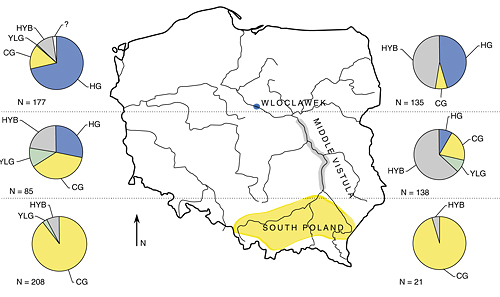
Fig. 3: Species structure in local large gulls populations, based on trapped birds (left side) and pair composition (right side) within the north-south gradient in Poland. HG = Herring Gull (individuals left, pairs right), CG = Caspian Gull, YLG = Yellow-legged Gull, HYB = hybrids or mixed pairs, ‘?’ = not identified individuals.
3.2.2. Population structure and mixed pairing within the north-south gradient
At Wloclawek Reservoir (‘northern zone), the population structure (based on 177 trapped birds in 2002-04) shows strong dominance of Herring Gull (126 individuals, 71%), followed by Caspian Gull (27 individuals, 15%) and hybrids (19 individuals, 11%), a single Yellow-legged Gull female and four unidentified birds (Fig. 3). Most of 19 birds classified as hybrids (16 individuals) showed characters intermediate between Herring Gull and Caspian Gull (Photo 3-4), and we suppose they were F1 hybrids. Six of them were ringed as chicks in Wloclawek colony during 1992-99 (1992: 1, 1993: 1, 1994: 2, 1999: 2), except for one bird that originated from the middle Vistula (ringed 1995 as a chick near Tyrzyn Dworski, 51°39’N, 21°38’E). Another two putative hybrids showed a mixture of characters of all three species (newly ringed 2003-04 as adults in Wloclawek) and one was clearly intermediate between Caspian Gull and Yellow-legged Gull (ringed as a chick in Wloclawek in 1995, Photos 5-6). Assuming that these birds are F1 hybrids (which seems probable as intermediacy is most likely to be detected in the F1 generation), this would indicate that hybridisation occurred in the colony at least since 1992. At Wloclawek Reservoir mixed pairs comprised about half of the breeding pairs sampled (samples averaged c. 33% of all pairs) during 2002-04. Moreover, about half of all mixed pairs in each season were comprised of two pure species - Herring Gull x Caspian Gull. Other mixed pairs included hybrids paired with pure birds or two paired hybrids. With four species categories distinguished (argentatus, cachinnans, michahellis and hybrids), mating in Wloclawek was not significantly different from that expected if taxa do pair at random (G-test: G2 = 7.11, df = 6, exact P = 0.43). Interestingly, however, in the 15 pairs of pure Herring Gull mated with other species or hybrids, 11 cases involved a male Caspian Gull or hybrid paired with a Herring Gull female while in only four cases a Herring Gull male was paired with a female of either Caspian Gull, Yellow-legged Gull or hybrid.
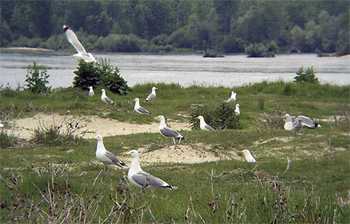
Photo 7: Part of the largest colony of large gulls in Poland, near Zaslow Karczmiski, middle Vistula. May 2004. Photo; G. NEUBAUER.
At middle Vistula (‘central zone’) 85 large gulls were trapped during 1995-1998 (Fig. 3). Among them, Caspian Gulls (32 individuals, 38%), Herring Gulls (24 individuals, 28%) and putative hybrids (19 individuals, 22%) were most numerous, with Yellow-legged Gulls being the rarest (10 individuals, 12%). Similarly to the ‘northern zone`, most hybrids showed characters intermediate between the two most numerous species, i,e. between Herring Gull and Caspian Gull. Despite high fluctuations in the number of breeding pairs, the percentage of pairs with both partners identified was rather high, on average 69%. The proportion of pure pairs was always lower or equal to the proportion of mixed pairs, and among the former the most frequent were pure Caspian Gull pairs, followed by Herring Gull pairs (Fig. 3). Again, among mixed pairs Herring x Caspian Gull pairs occurred most frequently.
Species structure in the ‘southern zone’ is the most homogenous, with very strong predominance of Caspian Gull, followed by hybrids (Fig. 3). Pure Herring Gulls were not recorded, but 11 of 16 hybrids showed characters intermediate between Herring and Caspian Gull (see FABER et al. 2001), Individuals intermediate between Caspian and Yellow-legged Gulls were less numerous. Data on pair composition in south Poland are scarce, due to difficulties with observations on the nests (dense herbage growth on islands): only in 21 pairs both birds were successfully assigned to species category, In 20 cases they were pure Caspian Gull pairs and one pair was comprised of Caspian and Yellow-legged Gull (2003, in Jankowice colony).
3.2.3. Other hybridisation cases
The only known case of hybridisation outside regularly studied colonies comes from Lower Silesia, SW Poland. A single mixed pair Caspian x Yellow-legged Gull was recorded at the Nysa Reservoir in 2000-01 (STAWARCZYK & TOM1ALOJC 2003).
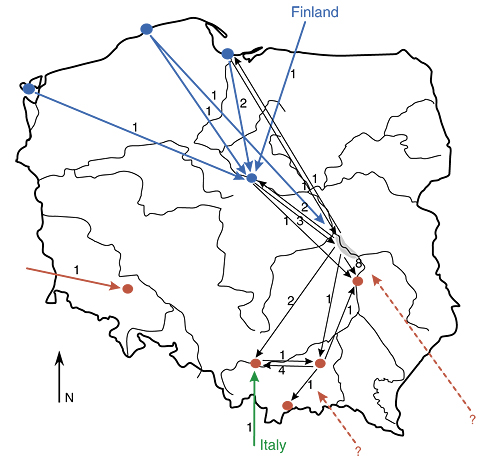
Fig. 4: Origin of foreign settlers in Polish colonies of large gulls and exchange of individuals between colonies within Poland. Numbers given at each arrow represent the number of individuals that moved between colonies and from abroad.
3.2.4. Origin of the central Polish population and exchange of birds between colonies within Poland
At the beginning, the population in central Poland was established by Herring Gulls from the Baltic Sea (Fig. 4), as six birds ringed as chicks at the coast were recovered as breeders at Wloclawek Reservoir colony and another one at the middle Vistula. The origin of the numerous Caspian Gulls that breed in Poland is not known, probably due to scarce ringing activities coupled with huge populations in the Ukraine. The only Caspian Gull of known origin, recorded at Mietkow Reservoir colony in 2001, was ringed as chick in another mixed colony near Sedlitz, E Germany in 1998 (T. STAWARCZYK, pers. comm,). The only Yellow-legged Gull of known origin was ringed in northern Italy and recovered on the nest in Jankowice in 2004.
In inland Poland, several movements of birds - ringed as either chicks or breeding adults and recovered as breeding birds - were noted, with almost equal numbers from north to south (from Wloclawek to middle Vistula, from middle Vistula to southern colonies) and in the opposite direction (from southern colonies to middle Vistula, from middle Vistula to Wloclawek and Vistula mouth). A significant east-west (five cases) and west-east (one case) exchange among southern colonies is documented as well (mainly between Tarnow and Jankowice, Fig. 4). Documented movements between middle Vistula and the southern zone concerned Caspian Gull, hybrids or Yellow-legged Gull (but not Herring Gull), whereas those between middle Vistula and the northern areas concerned Herring Gull, Caspian Gull or hybrids, but never Yellow-legged Gull. These data indicate that dispersal of birds occurs in almost all directions, with east-west movements dominating within the current range of Caspian Gull, and birds moving frequently in both directions along the north-south axis within the rest of inland Poland.
4. Discussion
Large gulls are new species in the breeding avifauna of Poland. All three species discussed here show a rapid range expansion and population increase, but in the case of Herring Gull this trend seems to be reversed more recently. Some old-established colonies in the coastal zone tend to decrease or even disappear for various reasons, among which, in two known cases, the competition with Great Cormorant Phalacrocorax carba (at Gardno and Lebsko lakes; GORSKI et al. 1990) and clutch predation by mammals (Wild Boar Sus scrofa and/or American Mink Mustela lutreola in Karsiborz islands, Szczecin Lagoon) are of greatest importance. Simultaneously, roof-top breeding became more common.
Caspian Gulls show a general trend of an extremely rapid increase, especially since 1990. However, the fate of particular breeding sites is highly variable (see above). The first breeding attempts are usually preceded by the presence of adult birds at the site for a few seasons. Numerous such observations made recently in southern Poland lead to the expectation of many new breeding sites appearing soon (P. SKORKA, pers. comm.) and suggest that the increase has not yet finished. As the Caspian Gull is the bigger, stronger, more aggressive bird and its laying peak is about one week earlier than in the Herring Gull (our unpublished data), the former is likely to win the possible competition between these two species. However, this may be considerably weakened due to partial mixing. Caspian Gull has bred as far north as in Wloclawek (locality 1 on Fig. 1 - the northernmost breeding site in Poland) since 1990, when among 29 pairs of Herring Gulls the first three pairs were observed. Few birds ringed 1991-92, as either chicks or breeding adults, were still breeding there during 2002-04. This suggests that the expansion of Caspian Gulls has started well before than it was documented, but precise data are lacking. The numbers of Yellow-legged Gulls breeding in Poland could be higher than stated here, due to identification problems: misidentification with yellow-legged Herring Gulls of omissus-type and hybrids, low awareness of observers plus difficulties of finding - usually single - birds or pairs of this species in dense inland colonies.

The distributions are taken from Malling Olsen & Larsson (2003). However; for Caspian Gull we have added shading (light green) to include recently colonized areas in Poland. This species has also colonized inland Russia, Belarus and Lithuania, and is known to breed in eastern Germany, but the paucity of data from these areas means that the distribution shown in this figure is best treated as approximate. The two black lines delimit the approximate hybrid zone, based on the best available current knowledge in 2010.
The hybrid zone extends for not more than 300 km of Polish lowlands from north to south, as only Herring Gulls are breeding north of Wloclawek Reservoir, whereas south of middle Vistula Caspian Gull is reported exclusively, with very few hybrids. The hybrid zone probably runs through the whole country from west to east, as mixed colonies are also reported east and west of Poland. Within the hybrid zone, as we mentioned earlier, mixed pairs constitute slightly less (Wloclawek Reservoir) or a bit more (middle Vistula) than half of the local breeding population. We can therefore estimate that, in absolute numbers, about 200 pairs of large gulls took part annually in hybridisation events in Poland. It seems to be characteristic that hybrids and hybrid pairs are most often a mixture of Herring and Caspian Gull, i.e. the two commonest species at both Wloclawek Reservoir and middle Vistula. Recoveries documenting movements of birds breeding in the hybrid zone support the hypothesis of probably unconstrained gene flow between northern Herring Gull and southern Caspian and Yellow-legged Gulls.
Hybridisation between closely related species is a relatively common phenomenon in birds (BARTON & HEWITT 1989), but usually occurs rarely in the areas inhabited by sympatrical, old, and stable populations of distinct taxa. On the other hand, inter-specific hybridisation may occur much more often in the areas of secondary contact established after expansion of one or two species. On newly colonised breeding sites at the edges of the breeding ranges, where one of the species is rare, and has limited chances to find the partner of its own species, inter-specific pairing may present the only mating option (MAYR 1963; HELBIG et al. 2002). The pattern of hybridisation among large gulls in Poland fits the classical scenario of a hybrid zone formed in the area of secondary contact of- three in this case - expanding and still closely related taxa. In the newly established zone of sympatry in central Poland, and in the apparent absence of differences in habitat selection, all three gull taxa interbreed to a large extent. At the moment, pairing seems random with respect to species identity. Apparently, other prezygotic isolation mechanisms (like the display behavior or morphological differences, PIEROTTI 1987; PANOV 1989) are not strong enough to preserve species from interbreeding. This is very much in contrast to the situation reported from the Black Sea coast (KLEIN & BUCHHEIM 1997), where Caspian Gull and Yellow-legged Gull are clearly separated by habitat choice alone (although Herring Gull is absent there) or the situation described from Atlantic coast of France (YESOU 1991), where Yellow-legged Gull does not interbreed with Herring Gull. The hybrid zone in Poland is very young, lasting probably for no more than only 2-3 generations and at the moment it is impossible to predict what happens in the next years.
Further studies are needed to establish whether the hybrid zone will persist, extend or perhaps disappear after a short transition period. Persistence of hybrid zones occurs frequently and may be maintained by a balance between dispersal of parental taxa into the hybrid zone and inferiority of hybrids (a ‘dynamic equilibrium’ scenario; MOORE & BUCHANAN 1985) or by local, ‘bounded superiority’ of hybrids (as in Western/Glaucous-winged Gull complex [Larus occidentalis/L,glaucescens]; GOOD et al. 2000). Lack of selection against hybrids may result in an extension of the hybrid zone and eventually even in a merging of the parental taxa. In any case, extensive hybridisation opens gates to extensive gene flow between formerly differentiated taxa, challenging their status of separate species. Such extensive introgression may be asymmetric, favouring expansion of genes and phenotypes of only one parental species. In line with this, Wloclawek data suggests that hybridisation of Caspian and Herring Gulls is driven mostly by males of Caspian Gull (and their hybrids) mating with Herring Gull females. This fits the data of LIEBERS et al. (2004) showing mtDNA polyphyly of Herring Gull. On the other hand, possible inferiority of hybrids should lead to reinforcement of mechanisms isolating the three taxa. Clearly, comparative data on the fitness of hybrids versus pure taxa are badly needed here. The phenomenon of hybridisation between large gulls, albeit relatively new, is not confined to Poland and probably includes other areas of inland, central Europe with eastern Germany, Poland, Belarus and Russia. Apart from Poland, mixed colonies of Herring and Caspian Gulls are known here from Volga River, central European Russia (MONZIKOV & PANOV 1996; PANOV & MONZIKOV 1999), probably also from eastern Germany (R. KLEIN pers. comm), and Belarus (YAKOVETS 2006).
Thus, relationships between all the three taxa, particularly between cachinnans and argentatus that recently developed on lowlands of central and eastern Europe may indeed be quite different from those reported from other areas of their contact as suggested a decade ago (CHYLARECKI 1993). It remains to be seen, whether such a situation is just transitionary or represent a more stable phenomenon. At the moment, numerous hybrids produced in the contact zone described above will certainly add to the difficulties in separating large gulls in the field. In more general terms, the situation described here adds a new layer of complexity to the already notoriously difficult taxonomy of the complex. At the same time, however, it provides a quite unique area of further exciting research studies exploring mechanisms and dynamics of the hybrid zone.
Acknowledgements: We especially would like to thank Jacek
ANTCZAK, Monika BUKACINSKA, Szyrnon BZOMA, Pawel GEBSKI, Michal JANTARSKI, Grzegorz KILIAN, Gerard POTAKIEWICZ, Arkadiusz SIKORA, Piotr SKORKA, Przemyslaw STACHYRA, Tadeusz STAWARCZYK, Pawel SZEWCZYK, Marcin URBAN and Piotr ZIELINSKI, who all provided significant amount of data on numbers and distribution of large gulls. We thank also prof. Maciej GROMADZKI for comments on the first version of the manuscript. Data on movements of birds between the colonies were obtained from the Polish Ringing Scheme (Institute for Omithology, Polish Academy of Sciences, Gdansk). Fieldwork was supported by the State Committee for Scientific Researches of Poland.
6. Literature
See PDF
 Larus cachinnans hybrid 4CY-7CY 81P1 December 2009 - November 2012, Roermond, the Netherlands.
Larus cachinnans hybrid 4CY-7CY 81P1 December 2009 - November 2012, Roermond, the Netherlands. Larus cachinnans 674P March 28 2013, Minsk, Belarus. Picture: Dmitry Goncharov.
Larus cachinnans 674P March 28 2013, Minsk, Belarus. Picture: Dmitry Goncharov. Larus cachinnans 4P12 12CY, March 02 2015, Jakuševec-Zagreb, Croatia. Picture: Luka Jurinovic.
Larus cachinnans 4P12 12CY, March 02 2015, Jakuševec-Zagreb, Croatia. Picture: Luka Jurinovic. Larus argentatus adult male P496 April 2004 & March 2013, Poland & Belarus. Photo: Greg Neubauer & Dmitry Goncharov.
Larus argentatus adult male P496 April 2004 & March 2013, Poland & Belarus. Photo: Greg Neubauer & Dmitry Goncharov. Larus cachinnans 956H adult, March 08 2015, Jakuševec-Zagreb, Croatia. Picture: ringing team Luka Jurinovic.
Larus cachinnans 956H adult, March 08 2015, Jakuševec-Zagreb, Croatia. Picture: ringing team Luka Jurinovic. 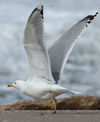 Larus cachinnans adult, March 02 2012, Ashdod, Israel. Picture: Amir Ben Dov.
Larus cachinnans adult, March 02 2012, Ashdod, Israel. Picture: Amir Ben Dov. Larus cachinnans adult, March 08 2011, Ashdod, Israel. Picture: Amir Ben Dov.
Larus cachinnans adult, March 08 2011, Ashdod, Israel. Picture: Amir Ben Dov. Larus cachinnans adult, March 08 2011, Ashdod, Israel. Picture: Amir Ben Dov.
Larus cachinnans adult, March 08 2011, Ashdod, Israel. Picture: Amir Ben Dov. Larus cachinnans adult, March 12 2011, Ashdod, Israel. Picture: Amir Ben Dov.
Larus cachinnans adult, March 12 2011, Ashdod, Israel. Picture: Amir Ben Dov. Larus cachinnans adult, March 19 2008, Ashdod, Israel. Picture: Amir Ben Dov.
Larus cachinnans adult, March 19 2008, Ashdod, Israel. Picture: Amir Ben Dov. Larus cachinnans adult, March 02 2012, Ashdod, Israel. Picture: Amir Ben Dov.
Larus cachinnans adult, March 02 2012, Ashdod, Israel. Picture: Amir Ben Dov. Larus cachinnans? adult, March 02 2012, Ashdod, Israel. Picture: Amir Ben Dov.
Larus cachinnans? adult, March 02 2012, Ashdod, Israel. Picture: Amir Ben Dov. Larus cachinnans adult, March 18 2013, IJmuiden, the Netherlands. Picture: Lars Buckx.
Larus cachinnans adult, March 18 2013, IJmuiden, the Netherlands. Picture: Lars Buckx. 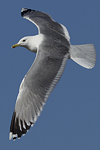 Larus cachinnans adult, March 28 2013, Ashdod, Israel. Picture: Amir Ben Dov.
Larus cachinnans adult, March 28 2013, Ashdod, Israel. Picture: Amir Ben Dov. 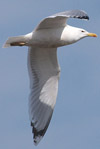 Larus cachinnans adult, March 22 2010, Dambovita river - Bucharest. Picture: Cristian Mihai.
Larus cachinnans adult, March 22 2010, Dambovita river - Bucharest. Picture: Cristian Mihai.